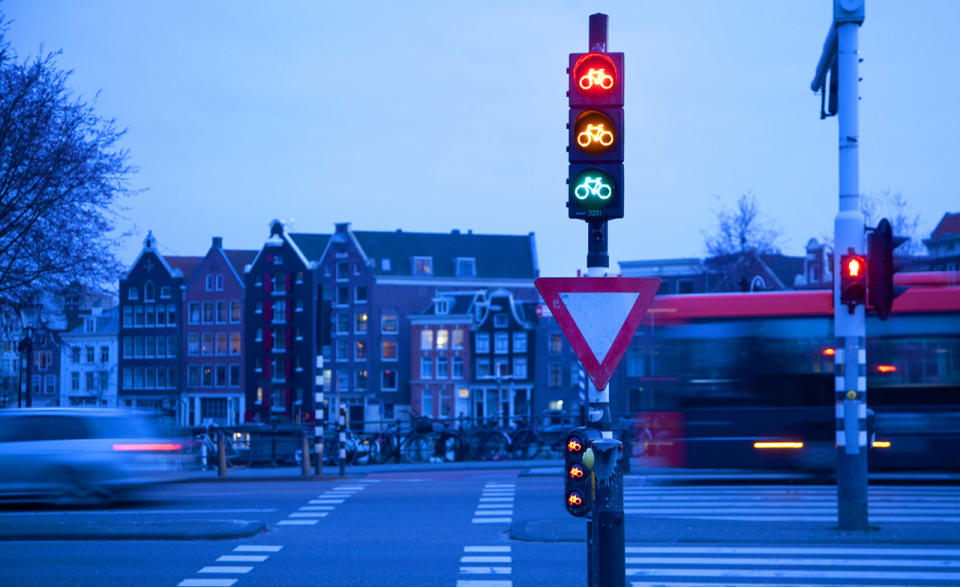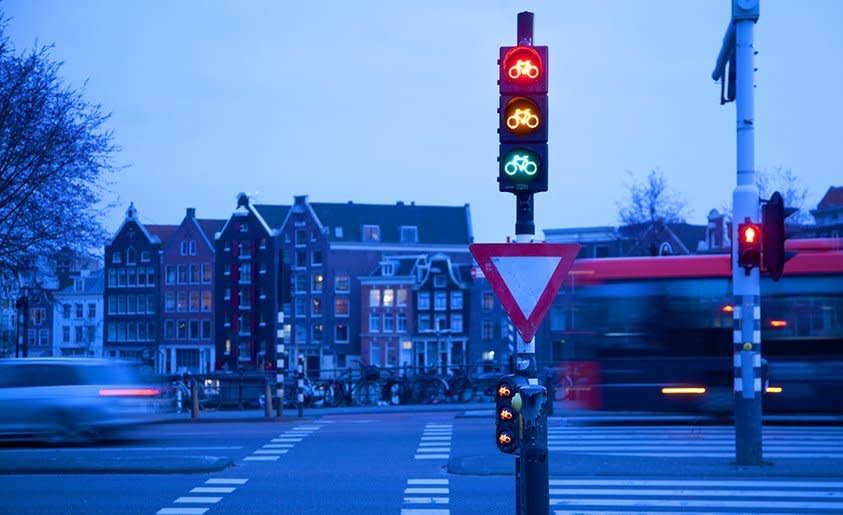The Story of Hans Monderman and the Safety of Insecurity


From the November 2016 issue
Perhaps you’ve heard of Hans Monderman. I hadn’t until recently. With a name like that, I imagined he was a cheese Danish or the guy who invented the spin cycle on Maytag washers. Instead, Monderman (1945–2008) was a traffic engineer in the Netherlands, where he offered to help speed the flow of traffic—as much as 22,000 cars daily through some intersections—in a town in Holland called Drachten. In response, Monderman apparently dialed his brain to its own spin cycle, because he ripped down every single traffic signal in the city.
Not only did he dismantle the signals, he also binned the speed-limit signs, no-parking signs, curbs, speed bumps, warning signs, railings, and directional lines painted on the asphalt. What he wanted were wide-open intersections—so-called “shared spaces”—and he wanted them to be a little intimidating, a little ambiguous. Drivers had to ask, “What, exactly, am I supposed to do here?”
Monderman’s idea was that motorists would take cues from observing other motorists. He wanted them to make eye contact and negotiate rights of way among themselves. His assumption was that when people feel insecure, they’re more attentive, patient, and alert—a voluntary behavioral change. It sounds like a recipe for Lusitania-quality catastrophe, with random C/D editors using the clear intersections as skidpads. (We would.) Instead, the intersections promoted a more efficient flow of cars, buses spent less time waiting, startup times were slashed, and accidents both declined and were less severe.
“Who has the right of way?” Monderman rhetorically asked. “I don’t care. People here have to find their own way, negotiate for themselves, use their brains.”
Imagine an NFL game where the yardage markers, end zones, and goal posts have all been removed. “Did he kick the ball through the uprights? Well, in my mind he did. High-five.”
See what I mean about disaster? Of course, relying on traffic engineers to keep us safe is your basic slopery slip slicked twice. For instance, consider what most of us do when facing a yellow light: We speed up, often dramatically, to tear through the intersection like torched weasels. Think about that. You speed up so that you barely miss the onslaught of cars that will momentarily be thundering toward your side doors? That’s not rational. But the reason we do it is that the stoplight somehow confers the illusion of safety, gives us the confidence that we have the right of way, tells us that someone else has “cured” the intersection of danger.

Traffic signs and bicycle lights in Amsterdam, Netherlands.
“A wide road with a lot of signs is telling a story,” Monderman asserted. “It’s saying, ‘Go ahead, don’t worry, go as fast as you want, there’s no need to pay attention to your surroundings.’ ” Which means you’re trusting a government official with your life. What if that official is oh, say, Rod Blagojevich? Of course, the scheme isn’t without pimples. For starters, shared-space intersections stop being efficient when drivers average more than about 20 mph.
I assume that’s because the time to make decisions becomes too slim. What’s more, elderly pedestrians and bicyclists sometimes loathe shared spaces, understandable if marked crosswalks exist only in your imagination. Sometimes, aggressive drivers realize they can take greater risks than unprotected bike riders and pedestrians, so a kind of “law of the jungle” emerges.
Conversely, shared space can also flummox timid drivers, who come to a complete stop and begin knitting sweaters to calm down. Unfortunately, travel speeds are dictated by the slowest driver. If you’d like to see timid drivers in action—well, in inaction—come to Ann Arbor. They’ll be waiting for you. Other distracted drivers—say, bowling-team captains with itchy skin conditions—can become so confounded by the sign-free intersections that they conclude it’s a good place to park. Heck, nothing said not to, right? Of course, a car blocking shared space eliminates the “shared” half of the equation and is too much like occupying Wall Street. Speaking of New York City, it probably won’t work there, either, because the highlight of every New Yorker’s day is a rancid dose of road rage via staged head-on collisions. Not that I’m bitter about NYC or anything.
So, should Monderman be planet Earth’s traffic guru? Beats me. The guy drove a green Saab, so, well, there’s that. And in one town where he removed all the signs, he erected another that said “Free of Traffic Signs,” which reminds me of Terry Bradshaw’s press conference to announce he wasn’t stupid. Still, there’s evidence that shared space works in certain locales—recently, West Palm Beach and Savannah.
If you could peer into Monderman’s brain, you might see that great 20th-century philosopher, Theodor Seuss Geisel, saying: “If you can see things out of whack, then you can see how things can be in whack.” In whack is good, but it means making things up as you go along, which also explains my career. Still, wouldn’t it be cool if, indeed, unsafe is safe?

 Yahoo Autos
Yahoo Autos 